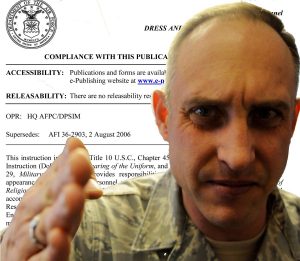Clean Out The Queep
The Air Force has revoked more than 226 Air Force instructions deemed unnecessary or outdated over the past year as part of its ongoing effort to get rid of so-called “queep.” In an interview at her Pentagon office Tuesday, Air Force Secretary Heather Wilson said the rescinded Air Force instructions contained 4,795 individual rules, or “compliance items,” that no longer need to be followed. AirForceTimes.com, August 29, 2018, Air Force Cuts 226 AFIs in Latest Salvo Against Hated Queep. Tech. Sgt. Kevin Wallace/Air Force illustrative photo
They had expected me to just go through the motions as had everyone before me. Instead, I read the complete Air Force instruction or regulation and made sure I understood what it wanted and why. In some cases, I was even able to dig up the US congressional testimony that motivated what eventually became the instruction or regulation. In many cases, there was a very good reason for what was required. Too often, however, it was just silly stuff that added no discernable value and was seemingly written by someone with either no clue at what they were doing or else some bureaucrat with too much time on their hands trying to justify their existence.
Taking the time to clean out the junk in a project is an unexpectedly useful activity. I’ve gotten rid of unproductive reviews and meetings. I’ve done away with useless charts, graphs, and reports. I’ve let contracts quietly lapse and did not renew them. I also often took a lot of heat for doing these things but in the end, taking the time and effort to get rid of things that didn’t need doing paid dividends in the future in terms of efficiency and productivity because we didn’t have to mess with them anymore.
See Stop Doing That as a project management tool
Note, this is different than just ignoring the activity and letting it hang over the project. The Air Force didn’t have to take the time and effort to rescind the instructions. They could have just ignored them, which I suspect was already happening, and pressed on with the mission. As simple as this seems it turns out that taking the time to remove the unnecessary activities and their written directives saves a surprising amount of time and effort in future projects.
At one of my Air Force assignments, we had a problem. The problem was that we had storerooms and cabinets filled with excess or obsolete PC equipment and software boxes. In one case there was a closet that literally had printers stacked to the ceiling because we had installed a local area network and could now share a few high-quality printers. All the individual printers that had come with each PC on this contract, before the days of local area networks, were no longer needed and were taking up valuable space in the offices. There was a prescribed way of disposing of excess equipment in the Air Force and it, of course, was based upon an Air Force Instruction and required paperwork and arranging shipping to remove the equipment. Not surprisingly, it seemed easier to not declare the equipment as excess and instead just hide it away somewhere. When we finally dealt with the problem, we were no longer periodically stressing out over the undeclared excess equipment and all the space it was taking up was now available for current mission activities.
See Provide A Service for the creative way we fixed our excess inventory problem.
Are you allocating time to clean out the unnecessary clutter in your project?
